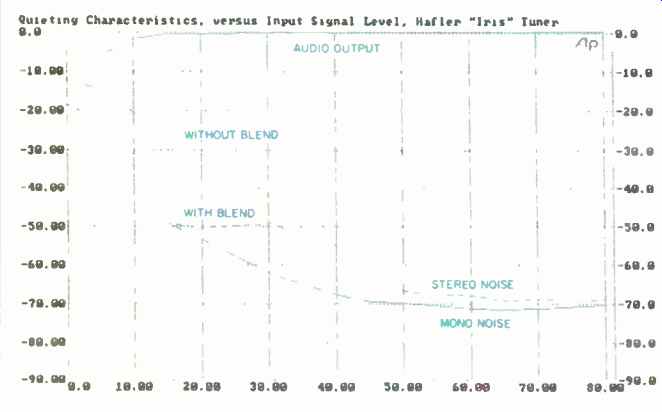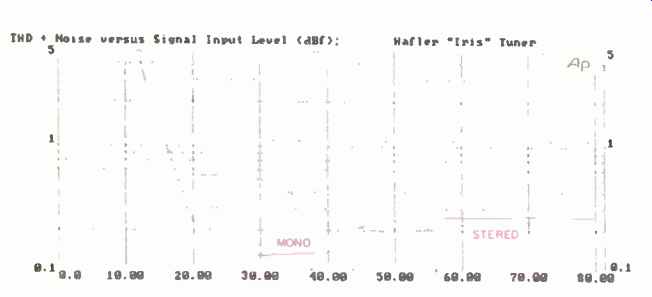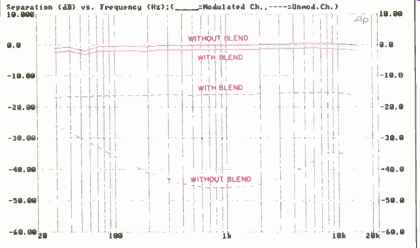
Manufacturer's Specifications:
Usable Sensitivity: Mono, 11.3 dBf.
50-dB Quieting Sensitivity: Mono, 17.2 dBf; stereo, 37.2 dBf.
S/N: Mono, 72 dB; stereo, 68 dB.
THD: Mono, 0.1%; stereo, 0.18%.
Capture Ratio: 1.5 dB.
Alternate-Channel Selectivity: 60 dB.
Separation: 45 dB at 1 kHz, 35 dB at 10 kHz.
Dimensions: 17 in. W x 3 in. H x 8 1/2 in. D (43.2cm x 7.6 cm x 21.6 cm).
Weight: 9 lbs. (4.1 kg). Price: $450.
Company Address: 613 South Rockford Dr., Tempe, Ariz. 85281, USA.
David Hafler, one of the true pioneers of the audio industry, and his engineering staff always designed components with the user in mind; their products were simple to operate yet laden with useful features rather than superficial buttons and controls. Although David Hafler sold his company to the Rockford Corp., the Iris FM tuner tested for this report is very much in the Haller tradition.
The Iris tuner was clearly designed to operate with the companion Iris preamplifier, for only then can the Hafler Handshake System be utilized. A single cable between the tuner and the preamplifier causes this to detect the tuner's presence; the pushbuttons of the preamp's remote are then automatically redefined to allow control of scanning and station presets. This system also mutes the tuner when other program sources are selected, preventing crosstalk into the other sources.
The Iris employs digitally synthesized, phase-locked-loop tuning, which operates in 50-kHz increments. It has five station presets, and since the "memory" needs no batteries, the last station selected and all presets will be retained if the unit is unplugged and reconnected, or even after a power failure. The Iris features "Scan," during which the tuning system pauses at each signal received for about 4 S. Scanning normally goes from low frequencies to higher ones, but the direction of scanning can be reversed, if desired.
There are five tuned circuits in the front-end, including a triple-tuned r.f. stage. Three dual-gate MOS-FETs are employed to provide good rejection of spurious signals and to reduce the possibility of generating IM distortion in the presence of high-level signals. Four ceramic filters are in the i.f. stages, and they have a flat group-delay characteristic for improved selectivity and low distortion. The tuner also has selectable muting as well as selectable stereo "Blend." Control Layout The five station preset buttons are at the lower left end of the front panel. Above them is an LED display for signal strength, to the right of which is the frequency display, including a small numeral "5" that illuminates when you are 50 kHz from an even or odd tenth of a megahertz. Further to the right, along the bottom section of the panel, are "Down" and "Up" tuning buttons. Holding down either one initiates a slow scrolling of frequencies that speeds up if you continue pressing the button. Next are "Scan" and "Stop" buttons; the latter is required for ending the scan. The "Store" button is deliberately separated from the five preset buttons, to avoid accidental storing of frequencies you really didn't want the tuner to memorize.
What Hafler calls special function switches come next: "Distant Station," "Mute Off," "Blend," and mono/stereo.
The "Distant Station" button does not affect sensitivity, which is always set to maximum in this tuner, but selects the signal threshold at which the station scanning function will stop. Above these four function switches are indicator lights for stereo reception, muting, and confirmation that the tuner has received a command from the remote supplied with the Iris preamplifier (if it is part of the system). The power switch is at the lower right corner of the front panel. The color of the panel can best be described as two-tone black, since it consists of a black-painted metal section into which has been installed a gloss-black plastic insert that runs almost the full width of the panel.
The rear panel houses the left and right output jacks, a 75-ohm coaxial connector, a terminal strip for connecting a 300-ohm twin lead, and an identical pair of multiple-pin connectors identified by the legend "Iris Data Bus." If the Iris preamp is in your system, it is to one of these data bus connectors that you would connect the flat ribbon cable supplied with the Iris tuner. The two connectors are internally wired in parallel to allow the digital data bus to "daisy chain" to other Iris-compatible accessories or components.
Measurements
Frequency response, not stated in the manufacturer's brochure, was virtually flat over the entire FM audio range from 30 Hz to 15 kHz. Response was off by no more than -0.2 dB at 15 kHz and by about -0.5 dB at 30 Hz. As shown in Fig. 1, output level for both channels was identical; it measured 600 mV for a 1-kHz signal at 100% modulation.
Figure 2 is a plot of the quieting characteristics of the tuner, in mono and stereo. From the upper solid curve, representing the tuner's audio output, you can see that full audio level has been reached at an input of barely more than 10 dBf. The lower solid curve shows mono quieting characteristics as a function of input signal strength; best S/N ratio for strong signals measured 71 dB. The dashed curves show the quieting obtained at various signal levels for stereo signals; best S/N was exactly 68 dB, as claimed.
Note that the stereo plot divides into two dashed curves below about 35 dBf. With the "Blend" control activated, the stereo noise blends with the mono noise so that, at around 15 dBf, full mono performance occurs, even in the presence of a stereo signal. If the "Blend" mode is not selected, full stereo reception is maintained all the way down into the noise. Fifty-dB quieting in mono was reached for signal levels of 16.5 dBf; in full stereo, the 50-dB quieting point was reached with an input of 35.0 dBf. Both results are slightly better than claimed by Haller.

Fig. 1-Frequency response.

Fig. 2-Quieting characteristics.

Fig. 3-THD + N vs. signal level.

Fig. 4-THD + N vs. frequency.

Fig. 5-Frequency response (top curves) and separation.

Fig. 6-Spectrum analysis, showing crosstalk products. See text.
Figure 3 shows how THD + N varied as a function of signal strength. From this plot, I obtained the figure for the tuner's mono usable sensitivity, which was 12.5 dBf. Best THD + N for strong signals fell somewhat short of the manufacturer's claims, with readings of 0.27% in mono and 0.25% in stereo for signal strengths of 65 dBf or more. In Fig. 4, I plotted THD + N versus frequency, using a constant 65-dBf signal. The very slight difference in distortion at 1 kHz between the tests in Figs. 3 and 4 is due to slight drifting of my FM generator's frequency between these tests. In Fig. 4, both mono and stereo THD + N are approximately 0.15% at this frequency. What's important here, however, are the values for the other two frequencies which must be checked as part of the IHF/IEEE Standard Measurements for FM Tuners, 100 Hz and 6 kHz. At 100 Hz, THD + N was 0.17% in mono and 0.3% in stereo. At 6 kHz, the results were 0.35% in mono and 0.34% in stereo.
Figure 5 is an analysis of separation with and without the "Blend" control activated. Without blend, separation measured just over 45 dB at 1 kHz and was 36 dB at 100 Hz. At 10 kHz, separation measured 35 dB, as claimed. With the "Blend" button pressed and the signal level lowered to around 35 dBf, separation decreased to approximately 17 dB and was fairly uniform over the entire FM audio range.
I plotted a spectrum analysis of the output of both channels while applying a 5-kHz signal at 100% modulation to the tuner's antenna terminals. Results are shown in Fig. 6.
The solid curve represents the output of the modulated channel, and the peak at 5 kHz establishes a 0-dB reference for this analysis. There is slight evidence of sidebands along the solid curve, each sideband 5 kHz removed from the 38-kHz difference subcarrier. The dashed curve represents the unmodulated channel's output. Without the extraneous signals present that are not pure 5 kHz, you can see that the actual crosstalk of the 5-kHz signal was down a full 50 dB compared with the signal's amplitude at the output of the modulated channel. Other components visible as crosstalk included some third harmonic of the 5-kHz signal (down some 68 dB below the 0-dB reference level) as well as a 19 kHz component (down around 65 dB) and the sideband components to either side of 38 kHz.
Alternate-channel selectivity for the Iris measured 65 dB, while capture ratio was very close to the 1.5 dB claimed.
The figure for i.f. rejection was better than 85 dB, image rejection was 80 dB, spurious responses were down more than 90 dB, and AM suppression was 58 dB.
Use and Listening Tests
I found the Hafler Iris tuner extremely easy to use. About the only unusual operating feature is the need to press the "Stop" button if you want to discontinue the scanning function. Because I am so accustomed to car stereo tuners and receivers that scan until you touch the tuning control (or try to memorize a signal in one of the presets), "Stop" seemed like a needless extra button to push. I found the ability to tune in 50-kHz increments extremely helpful in my listening location, where stations practically climb on top of each other. With strong enough signals, I found that I was able to detune by 50 kHz from the absolute frequency of the desired signal and was still able to enjoy distortion-free reception while eliminating adjacent interfering signals. Then, too, I'm told that many cable FM services are less than accurate when assigning station frequencies, so if you are a subscriber to cable FM, this feature may also prove to be quite useful.
The Iris pulled in every station I have ever been able to pick up at listenable signal strengths, which amounts to about 54 stations, some 47 of which were in stereo. I would hasten to add that this feat was only accomplished with the aid of an outdoor, multi-element rotatable antenna, which is mounted on my roof.
The owner's manual was somewhat on the brief side and did not list the manufacturer's performance specifications.
For these, I referred to a brochure supplied by Hafler upon request. Also, I felt that the discussion concerning the possible need for an outdoor antenna should have been placed in the front of the manual, under the section about installation, rather than at the back of the pamphlet, under the heading "Additional Information." Users may never get to the last page of the manual, even though it is only 12 small pages long. Aside from these minor matters, I am happy to report that the new management in charge of the Hafler name has created a component that is worthy of the Hafler designation.
--Leonard Feldman
(Source: Audio magazine, Feb. 1990)
Also see:
Hafler XL600 Power Amplifier (Feb. 1989)
Hafler DH-330 FM Tuner (Nov. 1986)
McIntosh Model MR-78 FM/Stereo, FM Tuner (Feb. 1977)
= = = =